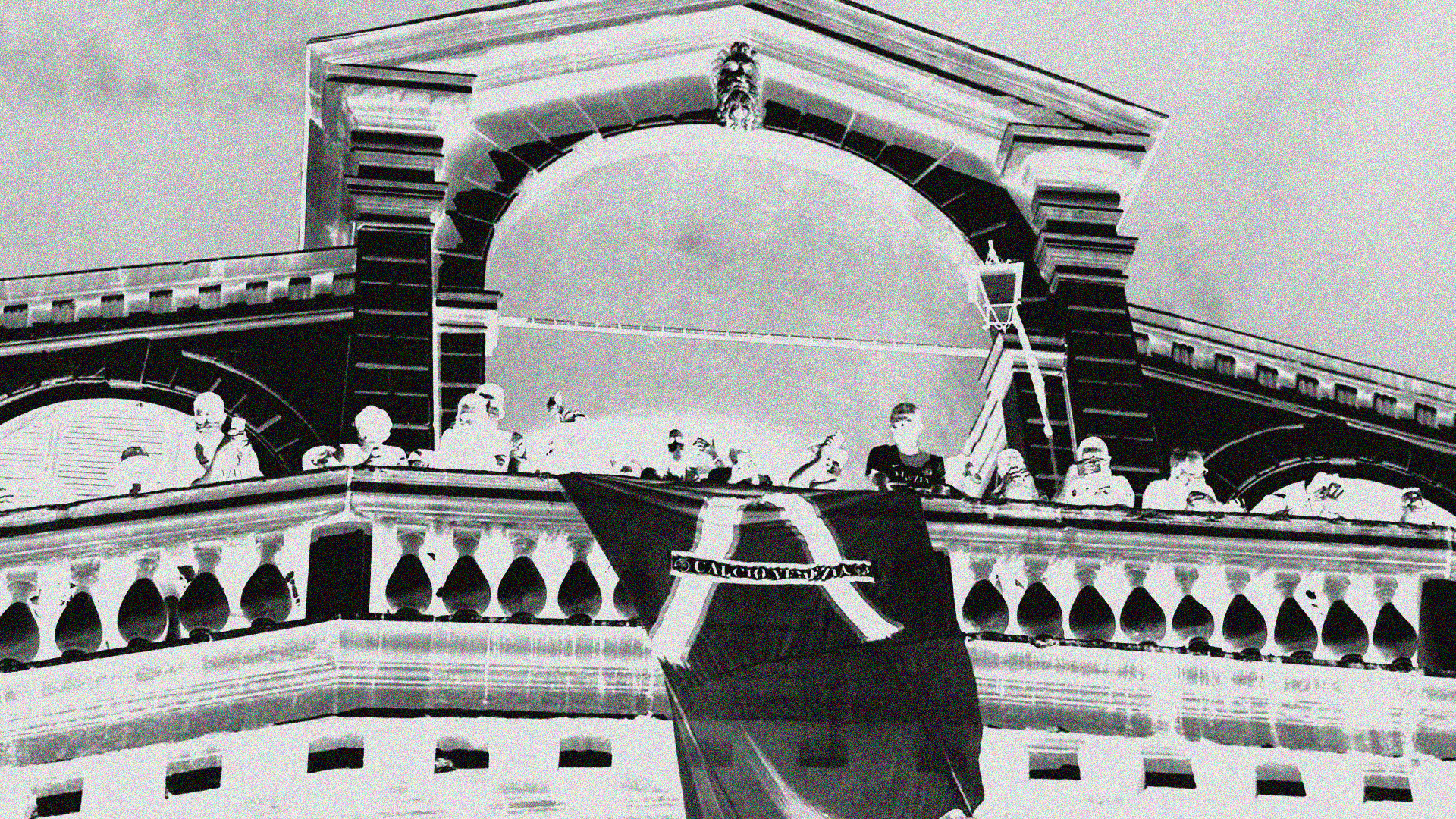
TCD Meets Venezia FC
Written by Liam Miller
Ending their 19 year absence from Serie A brought global acclaim. But at its heart, Venezia FC have retained the spirit of their humble beginnings. As their Chief Marketing Officer, Ted Philipakos points out, embracing that — rather than running from it — has been essential to their meteoric rise.
Venice is a city of paradoxes.
For a city with few paved roads, it has perfected the art of the street parade. Where religious flotillas like the Festa della Salute require a certain degree of solemnity, the atmosphere on this particular occasion was euphoric. After all, it was 19 years in the making.
An eclectic mix of boats big and small, narrowboats, rowing boats, dingys, inflatables – just about anything capable of buoyancy – worked its way through the streets. To the rear of the largest one, a well-organised formation of Gondolieri, in the ubiquitous striped shirts, steadied the vessel, artfully navigating the crowded waterways. The low bridges passing overhead were draped in banners and flags adorned in the orange, black and green colours that now go hand-in-hand with the city. Locals, tourists and supporters, armed with yet more flags, banners and scarves, formed bustling crowds of admirers, lining the canals. Heading towards the Piazza San Marco, a carnivalesque mood, usually reserved for the Carnevale di Venezia or the Festa della Sensa, descended on this ancient city.
This was a coronation for the city’s latest contribution to the annals of history. Just four days earlier, a dramatic play-off victory had confirmed the return of Venezia FC to the top flight of Italian football after almost two decades. But the years leading up to that summer of celebration were anything but smooth.
“It was a high-risk, high-reward situation,” admits Venezia CMO Ted Philipakos. “In 2015, the club fell into bankruptcy for the third time in 10 years,” he explains. “So it was an open question as to whether football was even viable in Venice.”
Surprisingly, nothing of that dire situation dissuaded Ted from joining a club in the fourth division of Italian football, thousands of miles from his native New York. In fact, it was the opposite.
“It was an open question as to whether football was even viable in Venice.”
“What attracted me was that Venezia was a blank canvas. The chance to create something, to add a new chapter to a long history, in a city as important as Venice. I felt a romanticism in starting from humble beginnings and growing something organically.”
In retrospect, Ted’s move is emblematic of the modern incarnation of Venezia FC.

A reliable rule of thumb in modern football is that short-term success is decidedly not an organic process. It requires a bullish, win-first manager, with an interchangeable pool of resources at their disposal, backed willingly by vast amounts of money. One only has to look at the precarious financial situation Inter Milan found themselves in last summer, just weeks after wrestling the Scudetto from the hands of Juventus.
The cost of winning is simply too high.
How is it, then, that a club of Venezia’s size – with its own recent history of financial ups and downs – has earned a share of the game’s global attention?
A meteoric rise from Serie D, one which included three promotions in five years, is a good explanation. On this subject, Ted is candid: “We weren’t expecting to go up last year. The target was to go up within two or three years.”
The catharsis of reaching Serie A after a 19 year period of turmoil and uncertainty, delivering cause for celebration to a city decimated by the impact of Covid-19, is a quirk of timing that would make a staunch atheist ponder the idea of divine intervention.
But life in Serie A didn’t change the outlook and attitude of the club, which points to another explanation for its resonance with a global audience: its authenticity. As Ted points out, it’s been the driving force behind everything.
“Our story comes from an honest place. It comes from a lot of love for our club and our city. And there haven’t been any hacks or tricks along the way, it’s been organic growth over time.”
Maintaining the essence of its own origin story, in the face of the all-too-tempting excesses that so often swallow up newly promoted football clubs, has been essential in keeping Venezia’s feet on the ground. The reality of competing in any way with the giants of Serie A is not lost on Ted.
“We’re the smallest city in the league, with the smallest stadium in the league, with the smallest budget in the league, and suddenly we’re here for the first time in two decades. It does still feel like a small club in many ways. But actually we embrace it,” he admits proudly.
“It’s just the reality - we have a pretty small team of people here making things, but it’s a passion project for all of us and we take pride in doing things at a Champions League level with a fraction of the resources.”
There is one area in which the club is truly, unequivocally elite: storytelling.
There is perhaps no other club in Europe capable of capturing the essence of its surroundings as well as Venezia. Given the Venetian tradition that carries centuries of the world’s most innovative and lasting creative expression on its back, it makes perfect sense that its club follows that intimately. Its ability to market itself in an authentic way is a nod to the heritage of a city that was once the centre of the marketplace of ideas.
The photography is uniquely-striking, and adds depth to the city’s breathtaking scenery – like when a chef adds a simple but subtle ingredient to add a layer of complexity to a famous dish. The matchday posters are dazzling creations, reminiscent of tour fliers from a 70’s underground post-punk band. The social media channels are distinctive and colourful, with a refreshing air of humility.
And then, there are the kits.
It's arguably what attracted the sort of global fanfare for which the club is now associated. Their shirts have been exceptional for a number of years now, but this year was different. All four brought the internet to a standstill on release – with good reason. They belong, quite frankly, in a gallery – surrounded by other Venetian contributions to art and culture. And just like any other famed relic, you should have to pay, queue up, and weep before their beauty.
“There’s been a lot of care that’s gone into creating a story that feels true to who we are, without getting too influenced by what else happens in the industry,” Ted reflects. “We’re always looking to honour tradition and at the same time seek out new territory in order to create something original, which is obviously a difficult balance to strike.”
And whilst he’s understandably guarded on the details, Ted reveals that the 2022/23 collection, designed by Bureau Borsche - the Munich studio led by Mirko Borsche and his team of designers, will go in a different direction.
“In approaching next season’s collection, we focused on this challenge, taking traditional aesthetics to a modern place, and I think it’s going to be something very exciting for us.”
Peeling back a layer, it’s clear that the marketing strategy is preceded by the quest to uphold the spirit and meaning of the club at all levels. It goes beyond the weaving of a narrative into a product.
The club’s annual photography residency is another string to its bow. Placing a camera in the hands of a local creator and allowing them to express their talent, documenting the genuine moments of emotion and passion that make up a football club, is an innovative feature that uplifts the work of young Venetians. This year the club is working with 21-year-old photographer Eric Scaggiante who, as Ted points out, was largely undiscovered, and had never been to a football match in his life.
“That only made me want to work with him more, because I thought it would be an interesting perspective. I like that he’s a local kid - it demonstrates that a football club is not just about winning a match on Sunday; at its best it’s there to uplift people, to let in all different types of people to express themselves and be a part of what we’re doing in their own way. Eric is a great example of that. He had no relationship with a football environment before, now he does.”
The delicate curation of each of these elements has rightfully thrust Venezia FC into the spotlight. But the whole approach becomes even more nuanced when you consider that the club is trying to tie together a number of disparate elements. The recent history and the shape of the club is reflective of the city as a whole. Following the 2015 bankruptcy, the modern Venezia FC was born out of a merger between the lagoon and the mainland.
“There’s a tension between both sides,” Ted explains. The blending of two different worlds is not an unknown feature for a city whose population is constantly in flux. It’s estimated that just 50,000 residents live on the lagoon, a stark contrast to the 20 million tourists the city sees annually. Even in the face of sudden global acclaim – so often a potential point of bitterness for seasoned football fans – Venezia’s ability to collectivise the love and attention for the club, whilst increasing inclusivity, is something a lot of clubs could learn from.
“At the same time, you have this tension between local and international, and whether the club is ever leaning too heavily to one side or the other. If we’re ever too local, that could be the next bankruptcy. If we’re ever too international, we could lose our authenticity. The club and the city both are about balance and harmony.”
As is true for football clubs in general, it is one of the few institutions in the city that is capable of bringing together its citizens en masse. The club is not afraid to cross cultural boundaries to achieve this. Partnerships and collaborations with galleries and museums, such as the Gallerie dell'Accademia and the Fondazione Musei Civici Venezia, bring together two realms that would simply coexist without interaction if it wasn’t for Venezia’s recognition of their responsibility. One thing Ted conveys is a refreshing self-awareness of the various avenues for which people might be interested in the club today, particularly the way in which the club acts as a portal to the city itself.
“We like to serve that. There are people who are just interested in the football, there are some just interested in the kits, but there are some people who have a more holistic relationship with the club – they read about our cultural partnerships, they like to get a window to the city of Venice. I think it’s another thing that helps build the identity of the club and establishes some kind of authenticity.”
For many clubs, achieving genuine inclusivity at all levels is an intimidating burden. For Venezia, that responsibility is weaved into the fabric of the club. It is perhaps Ted’s greatest source of pride.
“It’s incumbent upon us not to just play a football match and go home. It’s incumbent upon us to use football's power in a way that moves the city forward – that contributes some kind of good. I’ve always considered football to be a public good.”
And while a late flutter of positive results was not enough to save Venezia from relegation, Ted remains stoical on their position in the footballing landscape.
“The club is 114 years old. We’ve been up, down and up again over the years – the story goes on. We’ve been so conditioned by elite football you actually kind of have to remind people of that fact.”
This is where Venezia FC are outliers.
We live in a period of elitism. In life, in society, in football. The upper echelons are a closed-shop, circulating endless wealth and power amongst themselves, accumulating more and more attention and eroding the traditions of those beneath. Ted gets nostalgic in reminiscing of his own team, Panathanaikos, who regularly made the Champions League and for whom it wasn’t uncommon to get a win over giants like Barcelona or Juventus. Today, the chances of such feats recurring have more or less vanished. The diluting of competition is not only boring and inevitable; it’s soulless.
Venezia’s approach is one that thumbs its nose at the boom-and-bust reality of modern football, remaining true to their own values by championing bold ideas and the people of Venice.
While the Salernitana equaliser against Empoli was the Shakespearean dagger to the heart that confirmed their relegation to Serie B, Ted reflects warmly on the foundations that have been laid for a new chapter in Venezia’s cultural footprint. “I think, when you consider that a lot of what we’ve done has resonated with people around the world, that should give hope to other clubs like us.”
In a city of paradoxes, Venezia FC might just be the biggest of all. It is a relatively small football club. But its commitment to authenticity and overall outlook is as grand and life-affirming as one could possibly imagine.
And just as the world looked to Venice for inspiration many centuries ago, modern football - perhaps even society as a whole - could learn a lot from reviving that tradition again.









